
MSU Extension Supports Efforts to Improve Water Quality in Impacted Watersheds
DOWNLOADJuly 24, 2023 - Michigan State University Extension
Impacts
- 21% of the world's surface freshwater is found in the Great Lakes (EPA, 2023).
- 40% by 2025 is the goal that the Michigan Lake Erie Domestic Action Plan is aiming for in reducing phosphorus entering Lake Erie.
MSU Extension works to increase farmers’ success while protecting the environment, ensuring food safety, reaching new markets and advancing agriculture through applied research.
Priority Areas
The aesthetic, environmental and commercial value of the Great Lakes are vitally important to the entire region and the nation. The benefits of Michigan State University (MSU) Extension’s water quality efforts go beyond the state’s borders by helping to maintain the integrity of the Great Lakes. Research, education and outreach efforts in the Western Lake Erie Basin, Saginaw Bay and Macatawa Watershed have contributed to the work toward water quality goals across Michigan. MSU helps educate farmers on ways to reduce nutrient and sediment inputs in the Great Lakes.
Using Controlled Drainage Reduces Phosphorus Loss From Subsurface-Drained Fields
The main objective of the Edge-of-Field research project is to investigate the effectiveness of controlled drainage for reducing nutrient loss from subsurface-drained farms. The experiment had two half-fields, one with free drainage and the other with controlled drainage in Lenawee County, Michigan. Reductions in flow and loads were calculated based on the paired-field approach (Clausen & Spooner, 1993).
At the experimental site, MSU Extension specialists found that controlled drainage significantly reduced drainage discharge by 68% and nitrate load by 78% compared to free drainage. Because controlled drainage did not significantly affect nitrate concentration, drainage discharge reduction played a significant role in reducing nitrate load. Reduction of nitrate load with controlled drainage has been well documented (Gilliam et al., 1979; Helmers et al., 2022; Liu et al., 2019; Saadat et al., 2018; Tan et al., 1998; Williams et al., 2015). The combined results of this study and the literature show that controlled drainage is a promising practice in reducing nitrate load from drainage discharge.
Controlled drainage significantly reduced total phosphorus (TP) by 37% and drainage reduced phosphorus (DRP) by 20% compared to free drainage during the combined water years 2021 and 2022. Similar to nitrate, drainage discharge reduction was the main mechanism for TP and DRP load reduction under controlled drainage.
Although controlled drainage reduced phosphorus load during the combined water years 2021 and 2022, the performance of the system during each of the water years was different. The controlled drainage treatment had a positive impact on reducing phosphorus load in water year 2022, but it had a small adverse effect of releasing phosphorus load in water year 2021 (Figure 1).
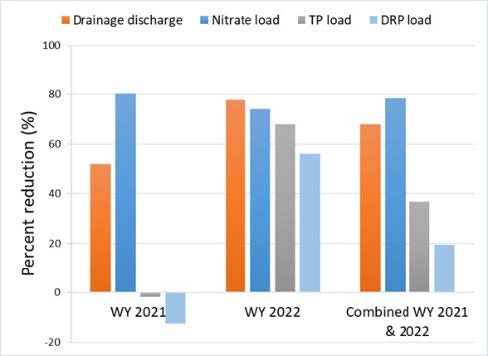
Preliminary results showed that controlled drainage significantly reduced nitrate and phosphorus load compared to free drainage during the combined water years 2021 and 2022. Therefore, controlled drainage showed potential as a promising practice for reducing nutrient loss from drainage discharge. Because of the varying response of the performance of controlled drainage in each of the water years 2021 and 2022, future work is needed to provide additional insight into the performance of controlled drainage under varying weather conditions. Other stakeholders have funded different aspects of this project in 2022, including the Michigan Department of Agriculture and Natural Resources (MDARD), the Michigan Department of Environment, Great Lakes, and Energy (EGLE) and the Corn Marketing Program of Michigan.
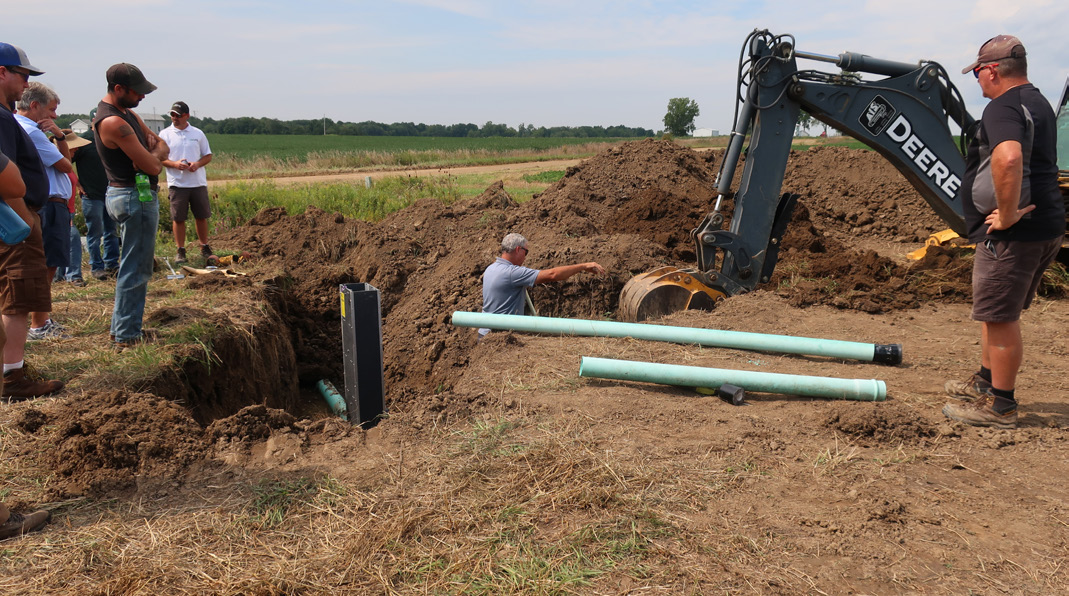
A demonstration field day was held in nearby Hillsdale County, part of the St. Joseph River Watershed that consists of the Maumee part of the Western Lake Erie Basin watershed. This is an area that is impacted by nutrient inputs from farms. There were 62 farmers and drainage practitioners in attendance.
The MSU soil health team discussed soil health tests, nutrient placement and variable-rate technology. MSU specialist Ehsan Ghane talked about saturated buffers and controlled drainage, a technology that allows water to be held in the field longer, allowing it to infiltrate into the water table rather than being immediately evacuated to the nearest stream. Attendees were able to watch as a saturated buffer was installed at the site. Educators used a drone to capture the installation to make a promotional video to expand the impact of the event.
St. Joseph River Watershed Project Reduces Phosphorus Loss from Farm Fields to Lake Erie
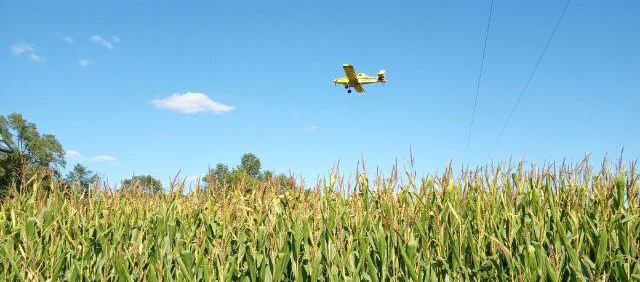
The MSU soil health team discussed soil health tests, nutrient placement and variable-rate technology. MSU specialist Ehsan Ghane talked about saturated buffers and controlled drainage, a technology that allows water to be held in the field longer, allowing it to infiltrate into the water table rather than being immediately evacuated to the nearest stream. Attendees were able to watch as a saturated buffer was installed at the site. Educators used a drone to capture the installation to make a promotional video to expand the impact of the event. Nutrient loading is the primary water quality issue in the Upper St. Joseph River Watershed and the broader Western Lake Erie Basin. A significant portion of the phosphorus contributing to harmful algal blooms in Lake Erie originates from surface and subsurface losses of commercial and organic fertilizer applied to agricultural land in the watershed. High nutrient and turbidity levels may also be the cause of inadequate dissolved oxygen levels found throughout the project area. This grant was funded for $199,836 for 1.5 years beginning Feb. 1, 2021, by EGLE and extended for another 1.5 years in 2023 for an additional $160,00 in cost share.
The most popular practices with the producers in the watershed have been cover crops and nutrient management. There have been 4,839 acres of cover crops installed in the watershed and 2,404 acres of nutrient management planning have been contracted. The estimated load reduction for the installed practices are 205 tons of sediment, 285 tons of phosphorus and 1,208 tons of nitrogen.
Increasing Water Quality Conservation Practices Within the Saginaw Watershed Farmer Network
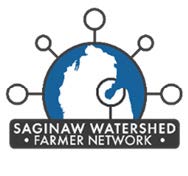
Farmers and agriculture advisors are banding together to learn and investigate water quality positive conservation practices that work for the Saginaw Watershed. Funding was granted from the Environmental Protection Agency in 2020 to reduce phosphorus loss into the watershed by creating peer-to-peer learning groups with farmers supported by MSU Extension, the Nature Conservancy, Michigan Farm Bureau and conservation districts. Four groups have been formed with farmer leaders in charge of planning meetings and communicating with members in their group. Through peer learning, the goal was to have greater uptake in education and conservation practice adoption. Resources created include videos (www.saginawfarmernetwork. org/success-stories) highlighting “The Bay Way” of water quality farming, a podcast series on the Michigan Field Crops Podcast (https://podcasts.apple.com/us/podcast/ michigan-field-crops/id1461704431?ign-mpt=uo%3D4)“In the Weeds” and articles around the benefits of water quality farming, such as “Eroding Away Your Economic and Environmental Progress” (https://www.canr.msu.edu/ news/eroding-away-your-economic-and-environmental-progress).
On July 25, 2022, the Saginaw Watershed Farmer Network held its first multi-county field day in Frankenmuth, Michigan, with the purpose of connecting existing members and recruiting new members to the network. There were approximately 60 attendees representing 10 counties in the region (Sanilac, Genesee, Gratiot, Bay, Saginaw, Shiawassee, Isabella, Lapeer, Tuscola and Huron) who identified as farmers, agribusiness professionals and agency representatives.
With a multimedia educational platform including in-person events and a unique farmer-to-farmer approach, MSU Extension is hopeful for a phosphorus reduction impact that lasts for years to come!
Conservation Reserve Enhancement Program Springs Back to Life in Michigan
Michigan’s Conservation Reserve Enhancement Program (CREP) was created to help protect our environment and wildlife. Michigan is partnering with the federal government to implement conservation practices of great significance to the state, and valuable to the nation, in matters of soil erosion, water quality and wildlife habitat.
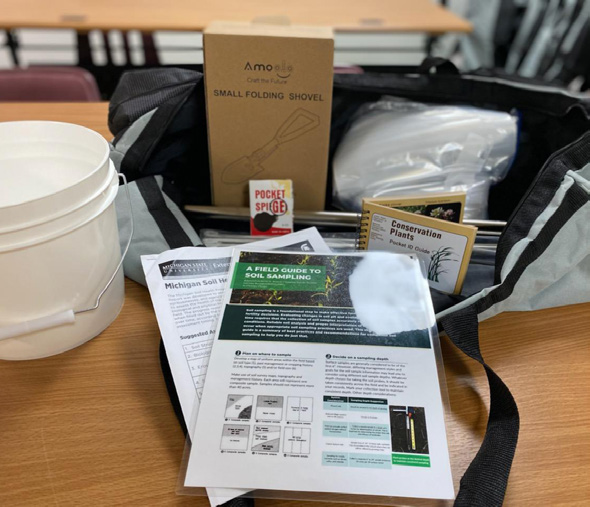
CREP is founded upon the federal Conservation Reserve Program (CRP) yet differs from the CRP by offering enhanced financial incentives for participants. In Michigan’s CREP, farmers and other landowners in priority watershed areas agree to enroll eligible parcels of land in the program for 15 years and establish prescribed conservation practices.
In return, landowners receive cost-share assistance in establishing conservation practices. Approved practices include introduced grass planting, native grass planting, field windbreak, filter strips, riparian forest buffers, wetland restoration and sediment retention-controlled structures.
Michigan’s CREP focuses on land in Lake Macatawa, River Raisin and Saginaw Bay Watersheds. It is dedicated to conservation practices that improve water quality and benefit wildlife. CREP will be key in reducing nonpoint source pollution in rural areas. The program will:
- Protect Michigan’s lakes, rivers, ponds and streams.
- Filter runoff water of silt, pesticides and other pollutants.
- Replenish water tables.
- Protect topsoil from erosion.
- Enhance wildlife habitat.
- Encourage wildlife diversity.
- Reduce flooding.
- Increase oxygen levels.
- Sequester carbon and improve soil health.
MSU Extension supports the efforts of MDARD by training the 60 field technicians who assist landowners in enrolling in CREP and other environmental programs. A team of MSU educators offered four unique workshops to train technicians in the basics of the program, promotion and marketing, and plant identification. In addition to live training, the team also assembled six instructional videos posted on the project website that technicians can refer to when they need help with skills concerning the installation of the CREP practices. Other tools were developed for the technicians to make the rollout of CREP simpler, such as step-by-step, phosphorus reduction heat maps, and promotional flyers and brochures.
References
Clausen, J. C., & Spooner, J. (1993). Paired watershed study design (No. PB-94-154820/XAB; EPA-841/F-93/009). Environmental Protection Agency. Office of Wetlands, Oceans and Watersheds.
Environmental Protection Agency. (2023). Facts and figures about the Great Lakes. https://www.epa.gov/ greatlakes/facts-and-figures-about-great-lakes
Gilliam, J. W., Skaggs, R. W., & Weed, S. B. (1979). Drainage control to diminish nitrate loss from agricultural fields. Journal of Environmental Quality, 8, 137–142. https://doi. org/10.2134/jeq1979.00472425000800010030x
Helmers, M. J., Abendroth, L., Reinhart, B., Chighladze, G., Pease, L., Bowling, L., Youssef, M., Ghane, E., Ahiablame, L., Brown, L., Fausey, N., Frankenberger, J., Jaynes, D., King, K., Kladivko, E., Nelson, K., & Strock, J. (2022). Impact of controlled drainage on subsurface drain flow and nitrate load: A synthesis of studies across the U.S. Midwest and Southeast. Agricultural Water Management, 259. https:// doi.org/10.1016/j.agwat.2021.107265
Liu, Y., Youssef, M. A., Chescheir, G. M., Appelboom, T. W., Poole, C. A., Arellano, C., & Skaggs, R. W., (2019). Effect of controlled drainage on nitrogen fate and transport for a subsurface drained grass field receiving liquid swine lagoon effluent. Agricultural Water Management, 217, 440–451. https://doi.org/10.1016/j.agwat.2019.02.018
Saadat, S., Bowling, L., Frankenberger, J., & Kladivko, E. (2018). Nitrate and phosphorus transport through subsurface drains under free and controlled drainage. Water Research, 142, 196–207. https://doi.org/10.1016/j. watres.2018.05.040
Tan, C. S., Drury, C. F., Soultani, M., van Wesenbeeck, I. J., Ng, H. Y. F., Gaynor, J. D., & Welacky, T. W. (1998). Effect of controlled drainage and tillage on soil structure and tile drainage nitrate loss at the field scale. Water Science and Technology, 38, 103–110. https://doi.org/10.1016/S0273- 1223(98)00503-4
Williams, M. R., King, K. W., & Fausey, N. R. (2015). Drainage water management effects on tile discharge and water quality. Agricultural Water Management, 148, 43–51. https:// doi.org/10.1016/j.agwat.2014.09.017



 Print
Print Email
Email




